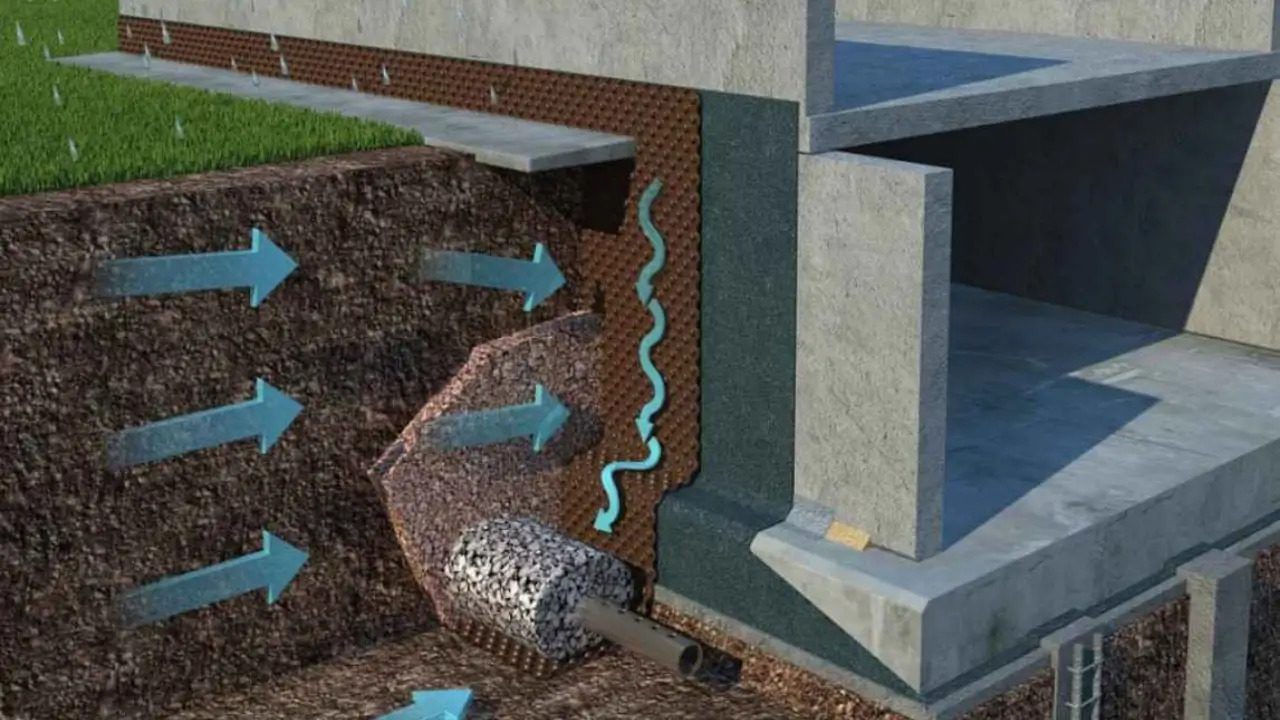
Waterproofing is a fundamental component in ensuring the durability, safety, and overall health of any building. Water is the most insidious and often invisible threat to structural integrity. Over time, moisture infiltrates from the foundation to the roof, compromising reinforced concrete, causing steel corrosion, and weakening the building’s load-bearing capacity. Internally, it leads to mold growth, dampness, unpleasant odors, and aesthetic deterioration.
Therefore, identifying all potential water ingress points and protecting them with the right waterproofing systems is essential for long-term structural performance.
This article outlines the primary areas of a building where waterproofing is necessary and explains the suitable solutions for each.
1. Foundation and Retaining Wall Waterproofing
Foundations are the most vulnerable part of any building. They are constantly exposed to groundwater, rainwater accumulation, and moisture-rich soil—especially in cases of inadequate drainage. When left unprotected, water seeps through the porous concrete, causing corrosion of the reinforcement, structural weakening, and rising damp in ground-floor walls.
Recommended waterproofing materials for foundations:
- Polyurethane-based liquid membranes
- Bitumen-based roll or brush-applied membranes
- Crystalline waterproofing mortars
During construction, a full tanking system should be employed, with external waterproofing applied to retaining walls and supported by a perimeter drainage system.
2. Roof and Terrace Waterproofing
Roofs and terraces are the most exposed areas of any structure, facing constant attack from rain, snow, and wind. Inadequate waterproofing here leads to water ingress, which damages concrete slabs, promotes mold, and causes leaks into interior spaces.
Flat and sloped roofs require different treatment methods. Terraces are especially prone to water accumulation, making proper slope design and high-performance waterproofing critical.
Commonly used materials in roof and terrace applications include:
- Pure polyurea coatings (high elasticity and mechanical strength)
- Polymer-modified bituminous membranes
- UV-resistant liquid-applied membranes
- Transparent waterproof coatings for tiled surfaces
For tiled terraces, flexible waterproofing layers that allow for tile installation should be applied beneath the ceramic layer.
3. Wet Area Waterproofing (Bathrooms, Kitchens, Utility Rooms)
Wet rooms are indoor areas where water frequently comes into contact with floors and walls. Bathrooms, kitchens, and laundry rooms are particularly susceptible to leakage, often resulting in water penetration to lower floors—an all-too-common issue in multi-unit buildings.
Key considerations for internal wet area waterproofing:
- Extend waterproofing at least 30 cm up walls from the floor level
- Pay special attention to details like floor drains and pipe penetrations
- Use tile-underlay waterproofing membranes to prevent seepage after tiling
Suitable products:
- Cementitious, two-component elastic waterproofing mortars
- Liquid-applied membranes such as Dryfix Water Block
- Polyurethane-based primers and coatings
Correct application and installer expertise are critical to long-lasting results in these areas.
4. Balcony and Eaves Waterproofing
Balconies and eaves are directly exposed to weathering and often structurally cantilevered from façades. Water ingress here can damage balcony slabs, stain façades, and leak into lower levels. Freeze-thaw cycles may cause ceramic tiles to lift or crack if water becomes trapped beneath.
Best practices for balcony waterproofing:
- Ensure adequate slope for drainage
- Always apply waterproofing before tile installation
- Reinforce junctions between railings and the floor with detailing accessories
Commonly used materials:
- UV-resistant waterproofing paints
- Transparent liquid membranes
- Flexible tile-underlay waterproofing mortars
On older structures, proper balcony waterproofing can significantly extend the building’s service life.
5. Swimming Pools and Water Tank Waterproofing
Pools and water reservoirs retain water continuously, requiring systems that can withstand constant hydrostatic pressure—often in reverse (negative) direction. These areas must be sealed to prevent both leakage and ingress of external contaminants.
Typical products used:
- Crystalline waterproofing mortars (resistant to negative water pressure)
- Epoxy or polyurethane-based coatings
- Flexible, dual-component waterproofing systems
- Solvent-free products certified for potable water contact
Surface preparation, moisture level control, and proper product selection are critical here. Post-application water-tightness testing is mandatory to verify performance.
A building’s longevity depends not only on its load-bearing system but also on how well it is protected against environmental stressors—chief among them, water. Moisture intrusion may go unnoticed for years, yet it causes some of the most severe structural and aesthetic damages.
A comprehensive waterproofing strategy should include:
- External and internal protection at the foundation
- UV-resistant, long-life solutions on the roof
- Meticulously detailed wet-area systems
- Weatherproof balcony and eaves protection
- Specialized products for pools and storage tanks
At Dryfix, we offer high-performance waterproofing solutions designed for every critical area of the building envelope. Our systems don’t just block water—they prevent mold, structural fatigue, and long-term degradation. Backed by expert technical support, our products are trusted across diverse applications—from foundations to rooftops.
